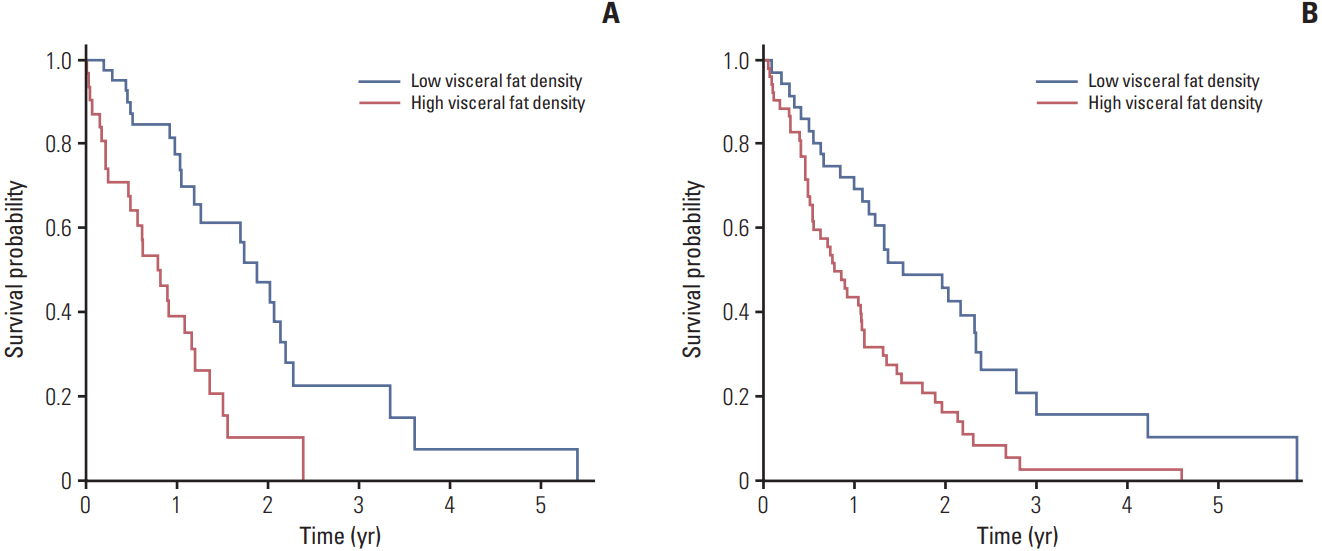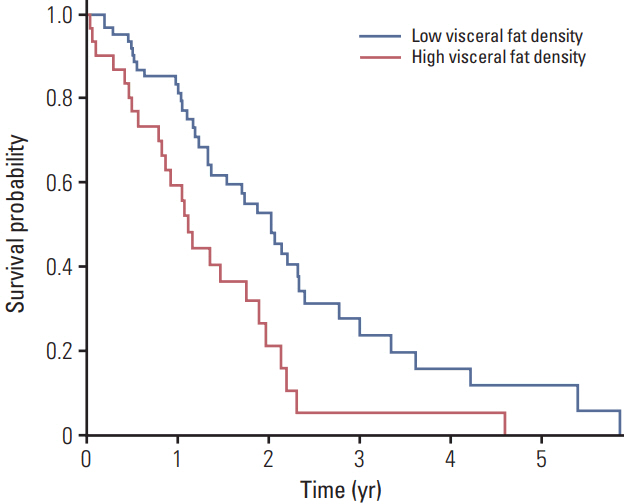Cancer Res Treat.
2018 Apr;50(2):530-537. 10.4143/crt.2017.156.
Body Composition Predicts Survival in Patients with Hepatocellular Carcinoma Treated with Transarterial Chemoembolization
- Affiliations
-
- 1Division of Gastroenterology, University of Michigan Medical School, Ann Arbor, MI, USA. gsu@umich.edu
- 2VA Ann Arbor Healthcare System, Ann Arbor, MI, USA.
- 3Department of Surgery, University of Michigan Medical School, Ann Arbor, MI, USA.
- 4Morphomic Analysis Group, University of Michigan Medical School, Ann Arbor, MI, USA.
- 5Division of Digestive and Liver Diseases, UT Southwestern Medical Center, Dallas, TX, USA.
- 6Veterans Affairs Center for Clinical Management Research, VA Ann Arbor Healthcare System, Ann Arbor, MI, USA.
- KMID: 2411141
- DOI: http://doi.org/10.4143/crt.2017.156
Abstract
- PURPOSE
The prognosis of patients with hepatocellular carcinoma (HCC) undergoing transarterial chemoembolization (TACE) is often uncertain. We aimed to utilize analytic morphomics, a high-throughput imaging analysis, to assess if body composition is predictive of post-TACE survival.
MATERIALS AND METHODS
We included patients from a single center (Ann Arbor VA)who had TACE as the primary treatment forHCC and had a pre-treatment computed tomography scans. Univariate analysis and multivariate conditional inference tree analysis were utilized to identify the morphomic characteristics predictive of 1-year survival. Results were validated in an external cohort (University of Michigan Health System) of HCC patients who underwent TACE as their primary treatment.
RESULTS
In the 75 patients in the derivation cohort, median survival was 439 (interquartile range, 377 to 685) days from receipt of TACE, with 1-year survival of 61%. Visceral fat density (VFD) was the only morphomic factor predictive of overall and 1-year survival (p < 0.001). Patients with VFD above the 56th percentile had a 1-year survival of 39% versus 78% for those below the 56th percentile. VFD also correlated with 1-year survival in the external validation cohort (44% vs. 72%, p < 0.001). In a secondary analysis, patients with higher VFD were significantly more likely to experience hepatic decompensation after TACE (p < 0.001).
CONCLUSION
VFD served as an objective predictor of mortality in patients undergoing TACE, possibly through its ability to predict hepatic decompensation. VFD may serve as a radiographic biomarker in predicting TACE outcomes.
MeSH Terms
Figure
Reference
-
References
1. Petrick JL, Kelly SP, Altekruse SF, McGlynn KA, Rosenberg PS. Future of hepatocellular carcinoma incidence in the United States forecast through 2030. J Clin Oncol. 2016; 34:1787–94.
Article2. Llovet JM, Bru C, Bruix J. Prognosis of hepatocellular carcinoma: the BCLC staging classification. Semin Liver Dis. 1999; 19:329–38.
Article3. Barman PM, Su GL. Limitations of the Barcelona Clinic Liver Cancer Staging System with a focus on transarterial chemoembolization as a key modality for treatment of hepatocellular carcinoma. Clin Liver Dis. 2016; 7:32–5.
Article4. Barman PM, Sharma P, Krishnamurthy V, Willatt J, McCurdy H, Moseley RH, et al. Predictors of mortality in patients with hepatocellular carcinoma undergoing transarterial chemoembolization. Dig Dis Sci. 2014; 59:2821–5.
Article5. Ryerson AB, Eheman CR, Altekruse SF, Ward JW, Jemal A, Sherman RL, et al. Annual report to the nation on the status of cancer, 1975-2012, featuring the increasing incidence of liver cancer. Cancer. 2016; 122:1312–37.
Article6. Jeon HJ, Shim EJ, Shin YW, Oh DY, Im SA, Heo DS, et al. Discrepancies in performance status scores as determined by cancer patients and oncologists: are they influenced by depression? Gen Hosp Psychiatry. 2007; 29:555–61.
Article7. Kelly CM, Shahrokni A. Moving beyond Karnofsky and ECOG performance status assessments with new technologies. J Oncol. 2016; 2016:6186543.
Article8. Englesbe MJ, Lee JS, He K, Fan L, Schaubel DE, Sheetz KH, et al. Analytic morphomics, core muscle size, and surgical outcomes. Ann Surg. 2012; 256:255–61.
Article9. Krishnamurthy V, Zhang P, Ethiraj S, Enchakalody B, Waljee AK, Wang L, et al. Use of analytic morphomics of liver, spleen, and body composition to identify patients at risk for cirrhosis. Clin Gastroenterol Hepatol. 2015; 13:360–8.
Article10. Sharma P, Parikh ND, Yu J, Barman P, Derstine BA, Sonnenday CJ, et al. Bone mineral density predicts posttransplant survival among hepatocellular carcinoma liver transplant recipients. Liver Transpl. 2016; 22:1092–8.
Article11. Stidham RW, Waljee AK, Day NM, Bergmans CL, Zahn KM, Higgins PD, et al. Body fat composition assessment using analytic morphomics predicts infectious complications after bowel resection in Crohn's disease. Inflamm Bowel Dis. 2015; 21:1306–13.
Article12. Singal AG, Zhang P, Waljee AK, Ananthakrishnan L, Parikh ND, Sharma P, et al. Body composition features predict overall survival in patients with hepatocellular carcinoma. Clin Transl Gastroenterol. 2016; 7:e172.
Article13. Yopp AC, Mansour JC, Beg MS, Arenas J, Trimmer C, Reddick M, et al. Establishment of a multidisciplinary hepatocellular carcinoma clinic is associated with improved clinical outcome. Ann Surg Oncol. 2014; 21:1287–95.
Article14. Patel N, Yopp AC, Singal AG. Diagnostic delays are common among patients wtih hepatocellular carcinoma. J Natl Compr Canc Netw. 2015; 13:543–9.15. Singal AG, Yopp AC, Gupta S, Skinner CS, Halm EA, Okolo E, et al. Failure rates in the hepatocellular carcinoma surveillance process. Cancer Prev Res (Phila). 2012; 5:1124–30.
Article16. Bruix J, Sherman M; American Association for the Study of Liver Diseases. Management of hepatocellular carcinoma: an update. Hepatology. 2011; 53:1020–2.
Article17. Huhdanpaa H, Douville C, Baum K, Krishnamurthy VN, Holcombe S, Enchakalody B, et al. Development of a quantitative method for the diagnosis of cirrhosis. Scand J Gastroenterol. 2011; 46:1468–77.
Article18. Zhang P, Parenteau C, Wang L, Holcombe S, Kohoyda-Inglis C, Sullivan J, et al. Prediction of thoracic injury severity in frontal impacts by selected anatomical morphomic variables through model-averaged logistic regression approach. Accid Anal Prev. 2013; 60:172–80.
Article19. Harbaugh CM, Terjimanian MN, Lee JS, Alawieh AZ, Kowalsky DB, Tishberg LM, et al. Abdominal aortic calcification and surgical outcomes in patients with no known cardiovascular risk factors. Ann Surg. 2013; 257:774–81.
Article20. Peterson MD, McGrath R, Zhang P, Markides KS, Al Snih S, Wong R. Muscle weakness is associated with diabetes in older Mexicans: the Mexican health and aging study. J Am Med Dir Assoc. 2016; 17:933–8.
Article21. Clark TW. Complications of hepatic chemoembolization. Semin Intervent Radiol. 2006; 23:119–25.
Article22. Kadalayil L, Benini R, Pallan L, O'Beirne J, Marelli L, Yu D, et al. A simple prognostic scoring system for patients receiving transarterial embolisation for hepatocellular cancer. Ann Oncol. 2013; 24:2565–70.
Article23. Kohla MA, Abu Zeid MI, Al-Warraky M, Taha H, Gish RG. Predictors of hepatic decompensation after TACE for hepatocellular carcinoma. BMJ Open Gastroenterol. 2015; 2:e000032.
Article24. Kirstein MM, Schweitzer N, Ay N, Boeck C, Lappas K, Hinrichs JB, et al. Experience from a real-life cohort: outcome of 606 patients with hepatocellular carcinoma following transarterial chemoembolization. Scand J Gastroenterol. 2017; 52:116–24.
Article25. Frenette CT, Osorio RC, Stark J, Fok B, Boktour MR, Guy J, et al. Conventional TACE and drug-eluting bead TACE as locoregional therapy before orthotopic liver transplantation: comparison of explant pathologic response. Transplantation. 2014; 98:781–7.26. Hui Y, Ruihua T, Jing L, Yaxiong L, Ji L, Linjie Y, et al. Metaanalysis of doxorubicin-eluting beads via transcatheter arterial chemoembolization in the treatment of unresectable hepatocellular carcinoma. Hepatogastroenterology. 2015; 62:1002–6.27. Mathew J, Slipak S, Kotru A, Blansfield J, Woll N, Shabahang M. Adherence to the BCLC guidelines and impact on overall survival. J Clin Oncol. 2014; 32(3 Suppl):Abstr.
Article
- Full Text Links
- Actions
-
Cited
- CITED
-
- Close
- Share
- Similar articles
-
- Transarterial Chemoembolization in Patients with Hepatocellular Carcinoma and Extrahepatic Metastasis
- Efficacy of Hepatic Arterial Infusion Chemotherapy and Radiofrequency Ablation against Hepatocellular Carcinoma Refractory to Transarterial Chemoembolization and Vascular Variation: A Case Study
- Complete Response of Single Nodular Large Hepatocellular Carcinoma with Pulmonary Metastasis by Sequential Transarterial Chemoembolization and Sorafenib: A Case Report
- Complications Related to Transarterial Treatment of Hepatocellular Carcinoma: A Comprehensive Review
- The Role of Combination of Transarterial Chemoebolization and Radiofrequency Ablation for Hepatocellular Carcinoma Treatment



